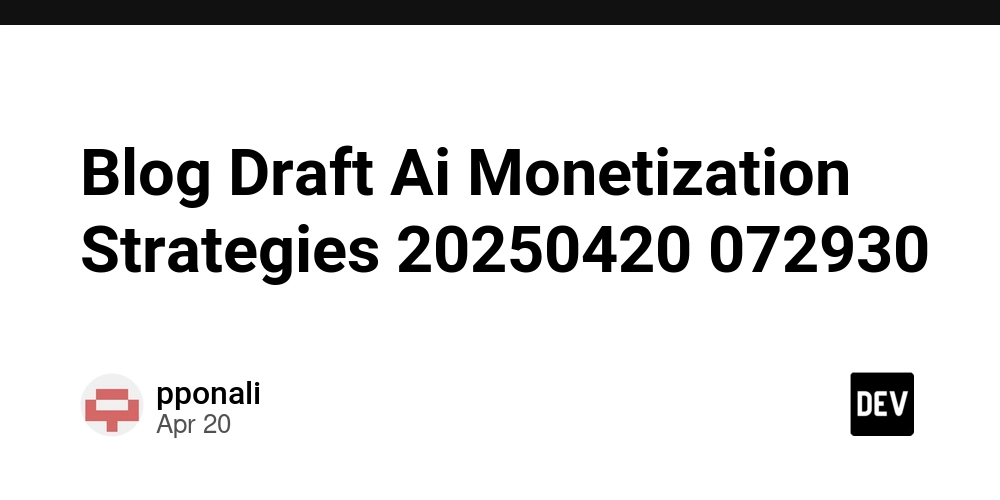Blog Draft Ai Monetization Strategies 20250420 072930
Blog Draft Ai Monetization Strategies 20250420 072930 Generated: 2025-04-20 07:29:30 Comprehensive Monetization Strategies for AI Technologies Introduction The rapid evolution of artificial intelligence (AI) continues to unfold a landscape ripe with opportunity. As businesses and individuals seek innovative solutions to enhance productivity, several monetization strategies cater specifically to this growing demand. This blog post delves into a comprehensive monetization plan for advancements in AI technologies, synthesizing conventional strategies with modern approaches to provide actionable insights for businesses and users alike. The aim is to explore various monetization avenues, elaborate on their potential effectiveness, and provide a roadmap for implementation that aligns with market trends and consumer expectations. 1. Understanding the Target Audience Segmentation A successful monetization strategy hinges on identifying and understanding the audience. The AI landscape can be broadly segmented into two categories: Businesses (B2B): This includes technology companies, healthcare institutions, financial corporations, startup incubators, and educational institutions. These entities seek out AI solutions to enhance productivity, innovate services, and gain competitive advantages. Individual Users (B2C): Primarily consisting of tech-savvy millennials, working professionals, students, and researchers, this group is increasingly interested in tools that leverage AI for personal and academic growth. Insights Research indicates a burgeoning optimism around AI advancements. Platforms like Microsoft 365 Copilot and OpenAI demonstrate the considerable potential of AI tools, resulting in an enthusiastic community of early adopters who actively seek out such innovations. Business leaders express a readiness to integrate AI tools into workflows, targeting efficiency and effectiveness improvements. 2. Core Value Proposition Mission Statement Our mission is clear: harness AI technologies to drive innovation, boost efficiency, and foster breakthroughs that empower both organizations and individuals. Unique Selling Points Efficiency: AI tools streamline mundane tasks, allowing users to concentrate on strategic initiatives that require human insight. Customization: Tailored AI solutions cater specifically to distinctive industry needs, thereby enhancing productivity in personalized ways. Innovation Leadership: By staying at the forefront of AI development, businesses can position themselves as thought leaders and trusted partnerships within the AI ecosystem. 3. Standard Monetization Streams 3.1 Subscription Models Description: A recurring monthly or yearly subscription model will provide access to AI-powered software services. This model is akin to offerings like Microsoft 365. Example: Crafting pricing structures similar to Microsoft 365, starting at roughly $30 per user/month, will accommodate small businesses to enterprise-level needs. Justification: This stream establishes a stable income source while meeting the continual demand for innovative AI tools among businesses that rely on ongoing technology access. 3.2 AI-Powered Applications for Businesses Description: Develop and license AI-powered applications geared toward businesses looking to integrate AI within their existing infrastructure. Examples: Customized solutions utilizing platforms like Azure AI Foundry, particularly designed for specific sectors like finance or healthcare. Justification: An observable correlation exists between increasing demands for operational efficiencies and the integration of AI applications, predicting widespread adoption across diverse sectors. 3.3 Affiliate Marketing Description: Establish an affiliate marketing program that connects businesses with leading AI tools, providing commissions for referrals made through content platforms. Examples: Strategic partnerships with innovations like OpenAI consist of promoting tools to interested users. Justification: This method addresses the rising enthusiasm for AI technologies, allowing businesses to tap into existing audiences eager to explore cutting-edge innovations. 4. Creative Monetization Streams 4.1 Digital Product Creation Description: Generate online courses, e-books, and other resources centered on AI tool utilization and optimizing productivity. Examples: Courses like "Maximizing Productivity with Microsoft Copilot” or “Everyday AI Tools for Efficiency.” Justification: Digitized educational offerings cater to the content demand from audiences seeking actionable insights, establishing digital products as a crucial monetization avenue. 4.2 Sponsored Content Description: Collaborate with tech companies to produce sponsored blogs or videos, which seamlessly integrate their AI techno

Blog Draft Ai Monetization Strategies 20250420 072930
Generated: 2025-04-20 07:29:30
Comprehensive Monetization Strategies for AI Technologies
Introduction
The rapid evolution of artificial intelligence (AI) continues to unfold a landscape ripe with opportunity. As businesses and individuals seek innovative solutions to enhance productivity, several monetization strategies cater specifically to this growing demand. This blog post delves into a comprehensive monetization plan for advancements in AI technologies, synthesizing conventional strategies with modern approaches to provide actionable insights for businesses and users alike.
The aim is to explore various monetization avenues, elaborate on their potential effectiveness, and provide a roadmap for implementation that aligns with market trends and consumer expectations.
1. Understanding the Target Audience
Segmentation
A successful monetization strategy hinges on identifying and understanding the audience. The AI landscape can be broadly segmented into two categories:
Businesses (B2B): This includes technology companies, healthcare institutions, financial corporations, startup incubators, and educational institutions. These entities seek out AI solutions to enhance productivity, innovate services, and gain competitive advantages.
Individual Users (B2C): Primarily consisting of tech-savvy millennials, working professionals, students, and researchers, this group is increasingly interested in tools that leverage AI for personal and academic growth.
Insights
Research indicates a burgeoning optimism around AI advancements. Platforms like Microsoft 365 Copilot and OpenAI demonstrate the considerable potential of AI tools, resulting in an enthusiastic community of early adopters who actively seek out such innovations. Business leaders express a readiness to integrate AI tools into workflows, targeting efficiency and effectiveness improvements.
2. Core Value Proposition
Mission Statement
Our mission is clear: harness AI technologies to drive innovation, boost efficiency, and foster breakthroughs that empower both organizations and individuals.
Unique Selling Points
Efficiency: AI tools streamline mundane tasks, allowing users to concentrate on strategic initiatives that require human insight.
Customization: Tailored AI solutions cater specifically to distinctive industry needs, thereby enhancing productivity in personalized ways.
Innovation Leadership: By staying at the forefront of AI development, businesses can position themselves as thought leaders and trusted partnerships within the AI ecosystem.
3. Standard Monetization Streams
3.1 Subscription Models
Description: A recurring monthly or yearly subscription model will provide access to AI-powered software services. This model is akin to offerings like Microsoft 365.
Example: Crafting pricing structures similar to Microsoft 365, starting at roughly $30 per user/month, will accommodate small businesses to enterprise-level needs.
Justification: This stream establishes a stable income source while meeting the continual demand for innovative AI tools among businesses that rely on ongoing technology access.
3.2 AI-Powered Applications for Businesses
Description: Develop and license AI-powered applications geared toward businesses looking to integrate AI within their existing infrastructure.
Examples: Customized solutions utilizing platforms like Azure AI Foundry, particularly designed for specific sectors like finance or healthcare.
Justification: An observable correlation exists between increasing demands for operational efficiencies and the integration of AI applications, predicting widespread adoption across diverse sectors.
3.3 Affiliate Marketing
Description: Establish an affiliate marketing program that connects businesses with leading AI tools, providing commissions for referrals made through content platforms.
Examples: Strategic partnerships with innovations like OpenAI consist of promoting tools to interested users.
Justification: This method addresses the rising enthusiasm for AI technologies, allowing businesses to tap into existing audiences eager to explore cutting-edge innovations.
4. Creative Monetization Streams
4.1 Digital Product Creation
Description: Generate online courses, e-books, and other resources centered on AI tool utilization and optimizing productivity.
Examples: Courses like "Maximizing Productivity with Microsoft Copilot” or “Everyday AI Tools for Efficiency.”
Justification: Digitized educational offerings cater to the content demand from audiences seeking actionable insights, establishing digital products as a crucial monetization avenue.
4.2 Sponsored Content
Description: Collaborate with tech companies to produce sponsored blogs or videos, which seamlessly integrate their AI technologies.
Examples: A YouTube series termed “AI in Action” could showcase myriad applications of AI tools, such as those offered by Azure.
Justification: Tech firms are investing in sponsored content as a promotional avenue, particularly within a B2B framework where brand visibility holds significant value.
4.3 Interactive Content Campaigns
Description: Design engaging challenges, such as coding competitions or hackathons, that immerse users in hands-on applications of AI.
Examples: An “AI Challenge” could galvanize community participation, fostering user-generated content and discussions.
Justification: Such interactive approaches elevate brand visibility while creating a steadfast community that contributes to ongoing dialogues surrounding AI advancements.
5. Implementation Priorities
5.1 Short-Term (0-6 Months)
- Launch affiliate marketing initiatives alongside developing digital educational products.
- Begin targeted advertising campaigns that highlight existing AI tools for businesses.
5.2 Mid-Term (6-12 Months)
- Introduce subscription models that encompass comprehensive training avenues for AI tool proficiency.
- Pursue partnerships for sponsored content and marketing outreach collaborations.
5.3 Long-Term (12 Months+)
- Explore expanding into interactive competition formats while continuously refining AI solutions based on collected user feedback.
- Seek and develop substantial partnership opportunities with significant AI tech firms for joint content creation and collaboration efforts.
6. Success Metrics
Key Performance Indicators (KPIs)
- Customer Acquisition Cost (CAC): Maintain a CAC below $20 for advertising efforts.
- Churn Rate: Strive for less than a 10% churn rate in subscription service offerings.
- Engagement Metrics: Monitor views, shares, and engagement across content-driven campaigns, targeting a growth rate of 30% month-over-month.
- Conversion Rate: Aim for an affiliate conversion rate at or above 12%.
Measurement Tools
- Utilize Google Analytics to monitor website traffic and conversion metrics.
- Employ Customer Relationship Management (CRM) tools for tracking customer feedback and subscription data.
- Leverage email analytics to gauge campaign effectiveness and user engagement.
Conclusion
The intersection of AI technologies and monetization strategies presents myriad opportunities to harness both traditional and innovative approaches in creating value. By understanding the landscape, identifying target audiences, and deploying effective monetization strategies, businesses can not only thrive but also lead within this dynamic space.
Moreover, fostering ongoing engagement through educational resources, community-driven content, and strategic partnerships will be critical to navigating the evolving expectations from both businesses and individual users in AI advancements. By establishing a comprehensive monetization plan, organizations can effortlessly align their offerings with market demands, ensuring sustained relevance and success amidst the rapid pace of AI growth.
With these strategies in hand, businesses are well equipped to take advantage of the vast potential within the AI technology landscape, driving not only profitability but also meaningful advancements in their respective sectors.







































































